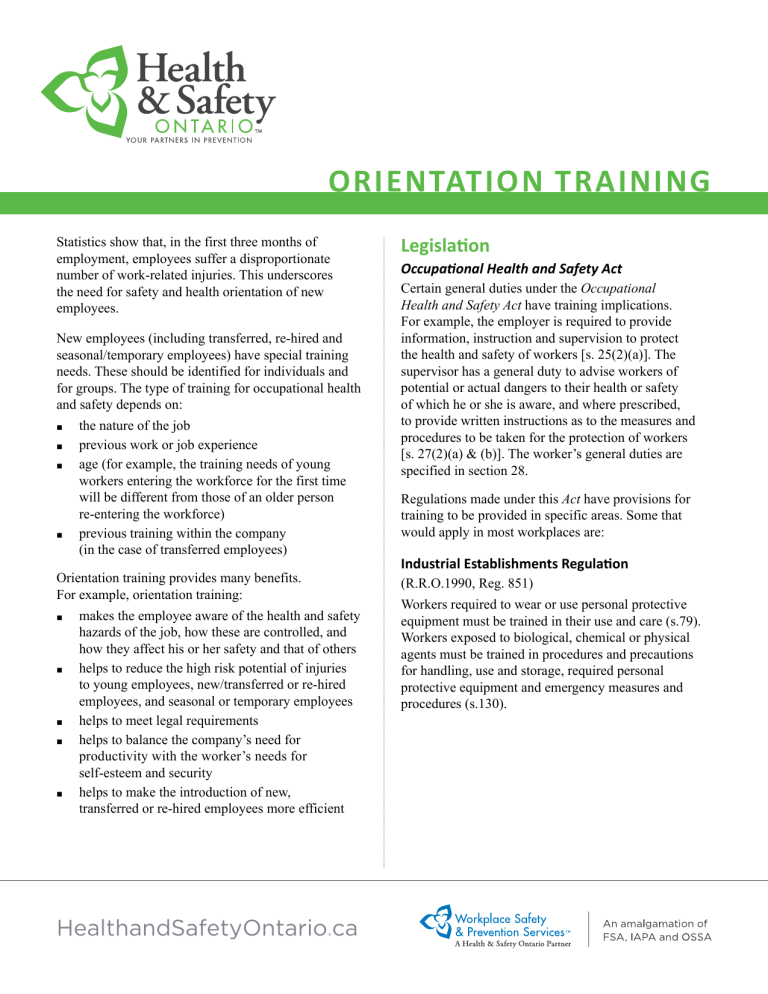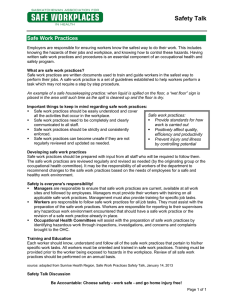
Orientation Training Statistics show that, in the first three months of employment, employees suffer a disproportionate number of work-related injuries. This underscores the need for safety and health orientation of new employees. New employees (including transferred, re-hired and seasonal/temporary employees) have special training needs. These should be identified for individuals and for groups. The type of training for occupational health and safety depends on: ■■ ■■ ■■ ■■ the nature of the job previous work or job experience age (for example, the training needs of young workers entering the workforce for the first time will be different from those of an older person re-entering the workforce) previous training within the company (in the case of transferred employees) Orientation training provides many benefits. For example, orientation training: ■■ ■■ ■■ ■■ ■■ makes the employee aware of the health and safety hazards of the job, how these are controlled, and how they affect his or her safety and that of others helps to reduce the high risk potential of injuries to young employees, new/transferred or re-hired employees, and seasonal or temporary employees helps to meet legal requirements helps to balance the company’s need for productivity with the worker’s needs for self-esteem and security helps to make the introduction of new, transferred or re-hired employees more efficient HealthandSafetyOntario.ca Legislation Occupational Health and Safety Act Certain general duties under the Occupational Health and Safety Act have training implications. For example, the employer is required to provide information, instruction and supervision to protect the health and safety of workers [s. 25(2)(a)]. The supervisor has a general duty to advise workers of potential or actual dangers to their health or safety of which he or she is aware, and where prescribed, to provide written instructions as to the measures and procedures to be taken for the protection of workers [s. 27(2)(a) & (b)]. The worker’s general duties are specified in section 28. Regulations made under this Act have provisions for training to be provided in specific areas. Some that would apply in most workplaces are: Industrial Establishments Regulation (R.R.O.1990, Reg. 851) Workers required to wear or use personal protective equipment must be trained in their use and care (s.79). Workers exposed to biological, chemical or physical agents must be trained in procedures and precautions for handling, use and storage, required personal protective equipment and emergency measures and procedures (s.130). Orientation Training Workplace Hazardous Materials Information System Regulation (R.R.O. 1990, Reg. 860) Workers who work with or near hazardous materials must receive training in the content of labels and MSDSs, procedures for use, care, handling and storage, procedures where fugitive emissions are present, and in emergency procedures. Refer to sections 6 & 7 of the WHMIS regulation for complete requirements. Furthermore, under section 42 of the Occupational Health and Safety Act, this training and worker’s familiarity with it must be reviewed at least annually and whenever changes are made in the workplace that affect worker health and safety. Designated Substance Regulation (O. Reg. 490/09) Affected workers must be trained in the use, care, and limitations of respirators, and in the provisions of the control program for the designated substances. The Codes for Medical Surveillance that are a part of these regulations contain requirements for specific health education. Training Program At a minimum, any orientation program should have provisions for: ■■ ■■ ■■ ■■ General training Job-specific training Allocation of responsibilities Measurement and evaluation General Training For the newcomer, this should include information about the company, its products, etc., and an explanation of: ■■ ■■ ■■ ■■ ■■ department functions reporting structures relationships with other departments standard operating procedures reporting of hazards Job-Specific Training Training and instruction should be provided in: ■■ ■■ ■■ the safety and health hazards of the job safe working practices, procedures and precautions (include applicable control systems such as lock-out or work permits) the use, care and maintenance of personal protective equipment Specific legal requirements, such as, for example, those required for instruction and training in hazardous materials, must be identified and addressed in the training that is provided. The forms provided in figures 1 and 2 will help you to identify the items to be covered in your orientation training program. 2 © 2011, Safe Workplace Promotion Services Ontario, publicly known as Workplace Safety & Prevention Services. 1 877 494 WSPS (9777) | 905 614 1400 | www.wsps.ca Orientation Training Allocation of Responsibilities Measurement and Evaluation In small firms, the responsibility for carrying out orientation training may rest with one person. In large firms, this responsibility may be shared between the manager, supervisors, the personnel department, the health and safety representative (H & S Rep) or joint health and safety committee (JHSC) and others. In either case, the employer or his/her delegate (senior manager) should provide the policy direction with respect to occupational health and safety orientation training. Some examples of responsibilities are: Set standards against which to monitor compliance with the orientation program. Keep records of all health and safety orientation provided including on-the-job training. This is useful for monitoring compliance. Personnel Manager ■■ ■■ ■■ ■■ ■■ Ensure policy is communicated and implemented Prepare orientation checklist and update this as necessary Plan and administer the formal program Assist and advise staff having orientation responsibilities Manager/Supervisor ■■ ■■ ■■ ■■ Ensure that the program is followed Review checklist in advance, update as necessary, establish priorities and schedule time for required training Ensure on-the job training is provided Keep records of orientation training provided H & S Rep/JHSC ■■ ■■ ■■ 3 Review program and recommend changes Must be consulted in the development and review of the hazardous materials training program May be required to assist in development and delivery of orientation training © 2011, Safe Workplace Promotion Services Ontario, publicly known as Workplace Safety & Prevention Services. 1 877 494 WSPS (9777) | 905 614 1400 | www.wsps.ca The orientation program should be evaluated periodically to assess its effectiveness in protecting employee health and safety. Identify the information needed to carry out this evaluation, collect and analyze it at regular intervals. Some examples of data that may be collected are: ■■ ■■ ■■ number of new employees in relation to the number trained number of new employees injured on the job number of new employees reporting hazards number of infringements of safety rules by new employees Such evaluations will help identify the strengths and weaknesses in the program so that appropriate action can be taken. Orientation Training Figure 1 Sample checklist of items that should be covered in an Orientation Program General Orientation Overview of the company Organization structure Company policy and procedures Pay rates (regular, overtime, etc.) Benefits (medical, insurance, etc.) Introduction to union, where appropriate Employee problems and concerns Work refusal procedure Grievance procedure Personnel records Communication Physical fitness Absenteeism, lateness, etc. Employee performance Awards program Safety and health policy General safety rules Legal responsibilities and rights Physical examinations First-aid facilities Fire safety plan and emergency procedures Reporting of hazards H & S Rep/JHSC Personal protective equipment (PPE) Use of tools and equipment General housekeeping Smoking restrictions 4 © 2011, Safe Workplace Promotion Services Ontario, publicly known as Workplace Safety & Prevention Services. 1 877 494 WSPS (9777) | 905 614 1400 | www.wsps.ca Job-specific Orientation Department functions Department tour Priorities Reporting structures Relationships within department and with other departments Security Types of assistance available What to do in an emergency Performance evaluations Specific duties and responsibilities Specific worker legal responsibilities Department occupational health and safety basics Department safety rules Information on hazards, controls, precautions and procedures Use of tools and equipment Materials/substances in use – hazards, handling, storage and disposal procedures Labelling systems/warning signs/MSDSs Use and care of PPE Housekeeping procedures Work permit systems Process hazards (e.g., toxic dusts) Hazards—loose clothing, jewellery Lifting and handling restrictions Safe stacking of materials Safety supplies and equipment Defective or inappropriate tools Correct use of guards Safe procedures for machines Maintenance of clear access and egress Notification of work-related injuries and illnesses Orientation Training Figure 2 Job Safety Analysis Job Description: _________________________________________________________ Job Location: ___________________________________________________________ Key Job Steps Machinery, Tools & Materials Used Potential Health & Safety Hazards Signature: _____________________________________________________________ Date: _________________________________________________________________ 5 © 2011, Safe Workplace Promotion Services Ontario, publicly known as Workplace Safety & Prevention Services. 1 877 494 WSPS (9777) | 905 614 1400 | www.wsps.ca Safe Practices, PPE & Safety Devices Orientation Training © Workplace Safety and Prevention Services 2011. Workplace Safety and Prevention Services (WSPS) grants permission to approved end users to reproduce this document in whole or in part, provided its intended use is for non-commercial, educational purposes and that full acknowledgement is given to the WSPS. Approved end users are firms registered with the Workplace Safety and Insurance Board. WSPS reserves the right to extend this permission to other stakeholders and interested parties by express written permission upon application. WSPS extends no warranty to materials amended or altered by the end user. Under no circumstances is this document, or any portion thereof, to be duplicated for purposes of sale or for external reproduction or distribution. Revised: March 2011 6 © 2011, Safe Workplace Promotion Services Ontario, publicly known as Workplace Safety & Prevention Services. 1 877 494 WSPS (9777) | 905 614 1400 | www.wsps.ca

